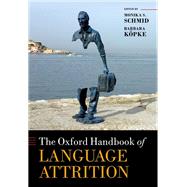- ISBN: 9780192863232 | 0192863231
- Cover: Paperback
- Copyright: 6/2/2022
Monika S. Schmid, University of Essex, Professor of Linguistics,Barbara Köpke, University of Toulouse (UT2), Professor of Neuropsycholinguistics
Monika S. Schmid is Professor of Linguistics at the University of Essex, having previously held positions at the Vrije Universiteit Amsterdam and the Rijksuniversiteit Groningen. Her research focuses on various aspects of first language attrition and has been published in journals such as
Bilingualism: Language and Cognition and Applied Psycholinguistics. She is the author of several books including Language Attrition (CUP, 2011) and First Language Attrition, Use, and Maintenance: The Case of German Jews in Anglophone Countries (Benjamins, 2002).
Barbara Köpke is Professor of Neuropsycholinguistics at the University of Toulouse 2 and head of the Octogone-Lordat Laboratory. Her research involves neuro- and psycholinguistic aspects of language processing in bilingual subjects with specific attention to 'extreme' situations such as L1
attrition, simultaneous interpreting, and aphasia. Her work has appeared in journals such as Language, Interaction and Acquisition and International Journal of Bilingualism, and she is the editor of a special issue of Journal of Neurolinguistics on first language attrition.
Monika S. Schmid and Barbara Köpke are co-editors, with Merel C. J. Keijzer and Susan Dostert, of Language Attrition: Theoretical Perspectives (Benjamins, 2007).
1. Introduction by Monika S. Schmid and Barbara Köpke
Part I: Theoretical Implications of Language Attrition
2. Language attrition and the Competition Model by Brian MacWhinney
3. Language Attrition and the Feature Reassembly Hypothesis by Michael T. Putnam, Silvia Perez-Cortes, and Liliana Sanchez
4. The Interface Hypothesis as a Framework for Studying L1 Attrition by Gloria Chamorro and Antonella Sorace
5. Implications of the Bottleneck Hypothesis for Language Attrition by Roumyana Slabakova
6. A Complex Dynamic Systems Perspective on Personal Background Variables in L1 Attrition by Conny Opitz
Part II: Psycholinguistic and Neurolinguistic Approaches to Language Attrition
7. Introduction to Psycholinguistic and Neurolinguistic approaches to language attrition by Barbara Köpke & Merel Keijzer
8. Language attrition as a special case of processing change: A wider cognitive perspective by Michael Sharwood Smith
9. Memory retrieval and language attrition: Language loss or manifestations of a dynamic system? by Jared A. Linck and Judith F. Kroll
10. How bilingualism affects syntactic processing in the native language: Evidence from eye movements by Paola E. Dussias, Jorge Valdés Kroff, Michael Johns, and Álvaro Villegas
11. First language attrition and Developmental Language Disorder by Elma Blom, Tessel Boersma, and Jan de Jong
12. Aging as a confound in language attrition research: Lexical retrieval, language use, and cognitive and neural changes by Eve Higby, Aviva Lerman, Marta Korytkowska, Taryn Malcolm, and Loraine K. Obler
13. Linguistic regression in bilingual patients with Alzheimer's disease by Melissa Barkat-Defradas, Frédérique Gayraud, Barbara Köpke, and Laurent Lefebvre
14. Electrophysiological approaches to L1 attrition by Karsten Steinhauer and Kristina Kasparian
15. Neuroimaging perspectives on L1 attrition and language change by Eleonora Rossi, Yanina Prystauka, and Michele T. Diaz
Part III: Linguistic Factors in Language Attrition
16. Introduction to linguistic factors in language attrition by Monika S. Schmid and Esther de Leeuw
17. Phonetic drift by Charles B. Chang
18. Phonetic attrition by Esther de Leeuw
19. Phonological attrition by Chiara Celata
20. Morphological attrition by Elena Schmitt
21. Lexical attrition by Scott Jarvis
22. Null and overt pronouns in attrition by Ayse Gürel
Part IV: Extralinguistic Factors in Language Attrition
23. Introduction to extralinguistic factors in language attrition by Monika S. Schmid and Mirela Cherciov
24. Age effects in language attrition by Emanuel Bylund
25. The impact of frequency of use and length of residence on L1 attrition by Monika S. Schmid
26. L1 attrition, L2 development, and integration by Gülsen Yilmaz
27. Language contact and language attrition by Claudia Maria Riehl
Part V: Second Language Attrition
28. Introduction to L2 attrition by Teodora H. Mehotcheva and Barbara Köpke
29. Exploring the impact of extra-linguistic factors on L2/FL attrition by Teodora H. Mehotcheva and Kleopatra Mytara
30. Syntax and phonology in L2 attrition: Modularity and resilience by Kathleen Bardovi-Harlig and David Stringer
31. L2 lexical attrition by Jenifer Larson-Hall
32. Attrition studies on Japanese returnees by Hideyuki Taura
33. Event-related potentials as metrics of foreign-language learning and loss by Lee Osterhout, Ilona Pitkänen, and Judith McLaughlin
Part VI: Heritage Languages
34. Introduction to heritage language development by Silvina Montrul and Maria Polinsky
35. Quantifying language experience in heritage language development by Sharon Unsworth
36. Intra-generational attrition: Contributions to heritage speaker competence by Fatih Bayram, Diego Pascual y Cabo, and Jason Rothman
37. 2L1 simultaneous bilinguals as heritage speakers by Tanja Kupisch
38. Language loss and language learning in internationally-adopted children: Evidence from behaviour and the brain by Lara J. Pierce, Fred Genesee, and Denise Klein
39. Childhood language memory in adult heritage language (re)learners by Janet S. Oh, Terry Kit-fong Au, Sun-Ah Jun, and Richard M. Lee
40. Language development in bilingual returnees by Cristina Flores
Concluding remarks by Kees de Bot
Annotated bibliography by Monika S. Schmidt
References
Index
The New copy of this book will include any supplemental materials advertised. Please check the title of the book to determine if it should include any access cards, study guides, lab manuals, CDs, etc.
The Used, Rental and eBook copies of this book are not guaranteed to include any supplemental materials. Typically, only the book itself is included. This is true even if the title states it includes any access cards, study guides, lab manuals, CDs, etc.
Digital License
You are licensing a digital product for a set duration. Durations are set forth in the product description, with "Lifetime" typically meaning five (5) years of online access and permanent download to a supported device. All licenses are non-transferable.
More details can be found here.






